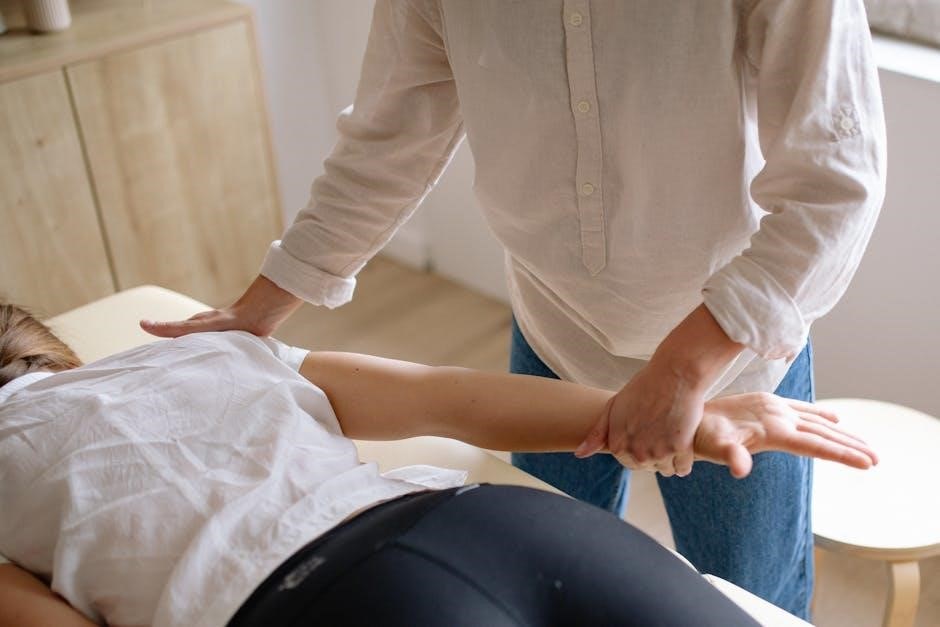Tibia and fibula fractures require a structured rehabilitation approach to restore lower leg function and mobility. Proper protocols ensure optimal healing and prevent long-term complications effectively.
1.1 Overview of Tibia and Fibula Anatomy
The tibia and fibula are two long bones in the lower leg, with the tibia being the larger, weight-bearing bone and the fibula acting as a stabilizer. The tibia connects the knee to the ankle, while the fibula supports the ankle joint. Both bones are connected by the tibiofibular joints, allowing minimal movement but providing structural integrity to the leg.
The tibia and fibula work together to facilitate walking, running, and balance, making their anatomy crucial for lower limb function and mobility. Their unique structure and joint connections ensure stability and support during various physical activities.
1.2 Importance of Rehabilitation in Recovery
Rehabilitation is crucial for restoring strength, mobility, and function after a tibia or fibula fracture. It helps prevent complications like stiffness or muscle atrophy, ensuring a return to normal activities. A structured program promotes healing, enhances flexibility, and rebuilds muscle strength, which is essential for regaining independence and improving overall quality of life post-injury.
Causes and Types of Tibia/Fibula Fractures
Tibia and fibula fractures often result from trauma, falls, or sports injuries. They can be classified as closed, open, transverse, oblique, or comminuted, varying in severity and treatment.
2.1 Common Causes of Tibia/Fibula Fractures
Tibia and fibula fractures frequently result from high-impact trauma, such as falls, car accidents, or sports injuries. Overuse and repetitive stress can also lead to fractures, particularly in athletes. Additionally, weakened bones due to medical conditions or aging may increase the risk of fractures from minor incidents. Accurate diagnosis is essential for effective treatment.
2.2 Classification of Fractures (Closed, Open, Transverse, Oblique, Comminuted)
Fractures are classified based on severity and characteristics. Closed fractures remain under the skin, while open fractures expose bone to external contamination. Transverse fractures are straight across the bone, whereas oblique fractures are diagonal. Comminuted fractures involve multiple bone fragments. Accurate classification guides treatment and rehabilitation, ensuring appropriate care for each fracture type and complexity.
Diagnosis and Imaging of Tibia/Fibula Fractures
X-rays and imaging techniques are essential for diagnosing tibia and fibula fractures. Proper radiographic views ensure accurate evaluation of fracture severity, alignment, and healing progress, guiding treatment decisions effectively.
3.1 Role of X-rays and Other Imaging Techniques
X-rays are the primary imaging technique for diagnosing tibia and fibula fractures, providing essential details about fracture type and severity. They help identify displacement, angulation, and fragmentation, which are critical for treatment planning. Advanced imaging like CT scans or MRIs may be used for complex fractures to evaluate soft tissue damage or joint involvement, ensuring comprehensive assessment and monitoring of healing progress in rehabilitation protocols.
3.2 Key Radiographic Views (AP, Lateral, Tibia/Fibula Series)
The AP (anteroposterior) and lateral views are standard for assessing tibia/fibula fractures, providing a comprehensive evaluation of bone alignment and displacement. The tibia/fibula series includes images from the knee to the ankle, ensuring full visualization of both bones. These views are critical for diagnosing fracture severity, monitoring healing progress, and guiding treatment decisions in rehabilitation protocols to ensure proper alignment and recovery.

Treatment Options for Tibia/Fibula Fractures
Treatment varies based on fracture severity, often involving non-surgical methods like casting or surgical interventions such as ORIF to stabilize and promote proper healing effectively.
4.1 Non-Surgical Management
Non-surgical management involves immobilization using casts or braces, particularly for stable fractures. Pain management is addressed with medication, and weight-bearing status is determined based on fracture stability. Early mobilization and physical therapy are introduced to maintain joint mobility and prevent stiffness. This approach is preferred for less severe fractures, ensuring proper healing while minimizing complications.
4.2 Surgical Intervention (ORIF and Other Techniques)
Surgical intervention for tibial and fibular fractures often involves Open Reduction and Internal Fixation (ORIF). This method stabilizes the bone with plates, screws, or nails, ensuring proper alignment. Other techniques include external fixation for unstable fractures. Surgery is typically recommended for severe, complex, or displaced fractures to restore anatomy and promote faster healing with minimal malunion risk.

Rehabilitation Protocol: Phases and Objectives
A structured rehabilitation approach involves three phases: acute, intermediate, and advanced. Each phase focuses on pain management, mobility, strength, and functional recovery to restore leg function fully.
5.1 Acute Phase (0-2 Weeks Post-Injury)
The acute phase focuses on pain management, swelling reduction, and immobilization. Ice, elevation, and limited weight-bearing activities are prioritized to protect the fracture and promote initial healing. Immobilization through casts or braces is essential during this period to ensure proper alignment and stability of the tibia and fibula, allowing the bones to begin the repair process effectively.
5.2 Intermediate Phase (2-6 Weeks Post-Injury)
The intermediate phase introduces gentle mobilization and controlled exercises to restore joint mobility and muscle strength. Weight-bearing status is gradually increased, and patients begin low-impact activities like swimming or cycling. This phase emphasizes soft tissue healing, improving range of motion, and strengthening the lower leg muscles without compromising the fracture site’s stability and healing progress.
5.3 Advanced Phase (6-12 Weeks Post-Injury)
The advanced phase focuses on restoring full strength, flexibility, and functional mobility. Patients progress to high-impact exercises, agility drills, and sport-specific activities. Emphasis is placed on proprioception training and balance exercises to enhance stability. This phase prepares individuals for a safe return to pre-injury activities, ensuring optimal recovery and minimizing the risk of future injuries or complications.
Physical Therapy Exercises for Tibia/Fibula Rehabilitation
Physical therapy exercises are crucial for restoring strength, mobility, and function post-fracture. They include range-of-motion, strengthening, and balance exercises tailored to promote recovery and prevent future injuries effectively.
6.1 Early Mobilization and Range of Motion Exercises
Early mobilization and range-of-motion exercises are critical in the initial stages of rehabilitation. Gentle movements, such as ankle pumps and toe curls, help prevent stiffness and promote healing. These exercises should be performed under professional guidance to avoid overexertion. Regular practice improves circulation, reduces swelling, and prepares the leg for more advanced strengthening exercises in later phases of recovery effectively.
6.2 Strengthening Exercises for Lower Leg Muscles
Strengthening exercises target the lower leg muscles, focusing on calf raises, heel slides, and resistance band workouts. Progressive resistance is applied to rebuild muscle strength and stability. These exercises are tailored to individual recovery stages, ensuring safe and effective progress. Supervision by a physiotherapist is crucial to avoid overstrain and promote proper muscle activation patterns throughout the rehabilitation process.
6.3 Balance and Proprioception Training
Balance and proprioception exercises enhance lower leg stability and joint awareness. Techniques include single-leg stands, wobble board use, and dynamic exercises. These activities improve neuromuscular control, reducing the risk of future injuries. Progression from stable to unstable surfaces challenges balance and restores functional mobility, essential for full recovery and return to daily activities or sports.

Recovery Timeline and Expectations
Recovery from tibia/fibula fractures typically takes several months, depending on fracture severity and treatment. Patients progress through weight-bearing stages, with full recovery usually achieved within 6-12 months.
7.1 Factors Influencing Recovery Time
Recovery time for tibia/fibula fractures varies based on factors like fracture severity, treatment method, patient compliance, and overall health. Open fractures and complications like infections or malunion can delay healing, while non-surgical cases may recover faster. Age and pre-existing conditions also play a role in determining the pace of rehabilitation and full recovery.
7.2 Return to Normal Activities and Sports
Return to normal activities and sports after tibia/fibula fractures depends on fracture severity and successful rehabilitation. Patients must achieve full strength, range of motion, and medical clearance. A gradual return is essential to prevent re-injury, with specific exercises for stability and strength. Most patients resume daily activities within a few months, while return to sports may take six to nine months post-injury.
Complications and Challenges in Rehabilitation
Common complications include infection, malunion, and nonunion of fractures. Challenges involve managing pain, limited mobility, and ensuring patient adherence to rehabilitation protocols for optimal recovery outcomes.
8.1 Common Complications (Infection, Malunion, Nonunion)
Infection is a risk, especially in open fractures, requiring antibiotics or surgical intervention. Malunion occurs when bones heal in incorrect alignment, potentially causing deformity. Nonunion happens when bones fail to heal properly, often due to inadequate blood supply or excessive movement at the fracture site, necessitating further treatment like surgery or bone grafting.
8.2 Addressing Rehabilitation Challenges
Rehabilitation challenges include pain, limited mobility, and patient non-compliance. Addressing these requires tailored therapy plans, patient education, and orthotic support. Gradual mobilization and monitoring progress help prevent setbacks. Early intervention for complications ensures a smoother recovery process, promoting optimal functional outcomes and reducing long-term disability effectively.
Role of Bracing and Orthotics in Rehabilitation
Bracing and orthotics provide essential support, stabilizing the tibia and fibula during recovery. They immobilize fractures, promote proper healing, and reduce discomfort, aiding in a successful rehabilitation process.
9.1 Types of Braces and Supports Used
Various braces and supports, such as CAM walkers, pneumatic braces, and splints, are utilized to immobilize and protect tibia/fibula fractures. These devices stabilize the lower leg, allowing proper healing and reducing pain. Orthotics like ankle-foot braces (AFOs) may also be used to support the ankle joint during recovery, ensuring alignment and preventing further injury.
9.2 Proper Use and Maintenance of Orthotic Devices
Proper use of orthotic devices involves wearing them as prescribed and following care instructions. Regular cleaning and inspections ensure durability. Tightening straps properly prevents skin irritation. Patients should avoid modifying devices themselves and schedule follow-ups for adjustments. Proper maintenance extends the life of orthotics, ensuring consistent support throughout the recovery process.

Importance of Patient Compliance and Education
Patient compliance and education are crucial for successful tibia/fibula fracture rehabilitation. Educating patients empowers them to follow protocols, ensuring proper healing and minimizing complications effectively.
10.1 Patient Education on Rehabilitation Protocols
Patient education is vital for effective tibia/fibula fracture rehabilitation. Clear communication ensures understanding of exercise routines, recovery timelines, and proper use of orthotic devices. This empowers patients to actively participate in their healing process, reducing risks of complications and promoting adherence to prescribed protocols for optimal outcomes.
10.2 Role of Patient Compliance in Successful Recovery
Patient compliance significantly impacts recovery outcomes. Adhering to prescribed rehabilitation protocols, including exercises and orthotic use, ensures proper healing and prevents setbacks. Consistent effort and commitment from the patient are essential for achieving full mobility and strength, making compliance a cornerstone of successful tibia/fibula fracture recovery.
Tibia/fibula fracture rehabilitation requires a comprehensive, patient-centric approach. Future advancements in orthotics and surgical techniques promise improved outcomes, enhancing recovery efficiency and patient satisfaction.
11.1 Summary of Key Rehabilitation Principles
Tibia/fibula fracture rehabilitation involves a phased approach focusing on pain management, inflammation reduction, and gradual mobilization. Strengthening, balance training, and functional exercises are prioritized. Patient compliance and adherence to protocols ensure optimal recovery. Proper bracing and orthotic use support healing, while avoiding complications like malunion or infection is crucial for achieving full lower leg function and mobility.
11.2 Advances in Tibia/Fibula Fracture Rehabilitation
Recent advancements include the use of Ilizarov techniques for complex fractures and 3D-printed orthotics for customized support. Virtual reality and biofeedback tools enhance patient engagement in physical therapy. Early mobilization protocols and minimally invasive surgeries improve outcomes, reducing recovery time and promoting faster return to functional activities with minimal complications.
